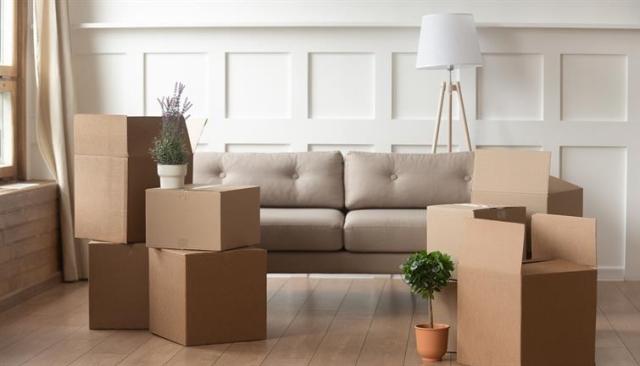You did it! You searched, you toured, and now you’re ready to move. Before you start packing up your current apartment to move to your new one, let’s make sure you’ve covered everything. Because while moving day is exciting, there are some challenges you might face. For example, moving into a new apartment isn’t easy, especially when stairs, tight corners, and doorways are involved. From packing a box to moving heavy furniture to knowing what ended up where, consider this your ultimate guide to moving day.
How to Prepare for Moving Day
Before you start your new adventure in your new apartment, you’ll want to make sure you say goodbye to your old place properly. While this may involve fond farewells with your favorite neighbors, that’s not the only part of leaving your old place behind. There are necessary steps to take when leaving an apartment, such as reviewing your lease agreement.
Your lease will outline everything you need to do when you choose not to renew. You’ll likely have to give advance notice, often in writing. The notice can range anywhere from 30 to 60 (in some cases, even 90) days, so do this before you do anything else. You’ll want to alert the community of your intention to move, you’ll want to contact your renters insurance and let them know you are moving, and yes, you’ll want to say goodbye to your wonderful neighbor who fed your cat while you were on vacation.
Four weeks before moving, start gathering supplies. You need boxes, packing tape, markers, basic tools such as a screwdriver and hammer, and some packing materials (paper or bubble wrap) for breakable items. You’ll also want a measuring tape. If you haven’t done so, measure your furniture to make sure it will fit in your new space. If you are able, measure the doorway of your new rental to see if it is wide enough for your largest furniture to pass through. If something won’t fit through the door, look for other openings, such as a large window, that might work instead. Try breaking oversized furniture down to make it smaller, such as removing doors from a cabinet or legs from a table. If something is simply too large to move, you might want to consider selling or donating it and getting something smaller after you settle in.
Two weeks before moving, you’ll want to fill out a change of address form with the USPS. You can do this online, in person, by phone, or by mail.
Where to find boxes for moving
While you can purchase boxes from any store that sells packing supplies, this could end up getting expensive. Consider purchasing specialty boxes such as a wardrobe box or a television/painting box for these delicate items. For everything else, call or visit your local grocery stores, retailers, and wholesale clubs. They often have plenty of boxes and will let you take as many as you want. Some stores will tell you which day is best for getting boxes, such as their delivery day.
If you want to cut down on the number of boxes you’ll need, plastic bins are great for carrying more items since they are sturdier than cardboard, and some have wheels to make moving them easier. Bonus: you can use these bins for storage in your new apartment.
If you live near a university, the bookstore might have some heavy-duty (and often smaller) boxes, so be sure to call and ask. Recycling centers can also be a great resource for free boxes.
If you are hiring movers, they will often sell you boxes. If you are willing to pay roughly two dollars per box rather than gathering boxes yourself, this might be an option worth considering.
When to start packing to move
You’ll want to start packing at least two weeks before you move. Even if you don’t think you have that much to move, it’s always more than you think! Besides, it’s better to be prepared a little too early than to be scrambling to finish packing the night before you move.
How to pack a box
First, gather packing supplies. You’ll need your box, packing tape, paper to wrap things with, a marker, a dust rag (you’ll find plenty of dusty knickknacks and what-nots when you start pulling things out of cabinets and off of shelves), and some resealable plastic bags to contain tiny items that could get lost and liquids that might leak.
Start by packing items that won’t break and will add some protection for more delicate items. For example, in the kitchen, pack a layer of dish towels first before tackling your glassware. You can also layer the bottom of the box with some newspaper or bubble wrap.
Small boxes work great for heavy items like books. They also come in handy for things you want to keep together like your silverware. Don’t overpack your box – you need to be able to lift it – but don’t under-pack it either. If the box doesn’t have enough in it, it might get squashed or the items might jostle around too much, which could break delicate items..
Be sure to pack delicate items very carefully. Wrap them in several layers of paper or bubble wrap and consider taping down each layer to make sure the wrap doesn’t shift or come off during the move.
Try to pack one room at a time. You will, inevitably, run to another room to find things to “fill in” the gaps. When you do this, choose items you won’t be looking for later. You’ll have a difficult time finding it if it winds up in the wrong box (for example, don’t put your toddler’s favorite stuffed animal in with your pots and pans).
When you’re done, tape the box closed and label it. Write the room and the main contents, if possible. This way, every box can be placed in the correct room in your new apartment. If the main contents are written on the box, you won’t be searching through every box marked “kitchen” to find your coffee maker and mugs.
If you like to be very organized, consider numbering each box and keeping a list of the contents in a notebook or on your phone (Living Room, Box 1: Living room photos, vases, and artwork).
Consider wrapping your furniture to protect it, and to protect your new apartment walls from any scratches or dings from your furniture’s sharp corners.
What not to pack when moving
There are things you shouldn’t pack. Here are things you’ll want to keep with you or dispose of properly:
- Valuables and irreplaceable items and documents
- Flammables and explosives
- Houseplants
- Perishable foods
- Medications
Rather than packing everything, think about what you might need if you can’t unpack right away or the movers get delayed. Here are some things to bring with you for your first night:
- Your child’s necessities (favorite snacks, blanket, diapers)
- Your pet’s necessities (food, water, bowls, leash)
- Paper towels and a roll of toilet paper
- Toiletries, eyeglasses, and other essentials
- Phone and charger (make sure your phone is fully charged on moving day)
- A set of clothes for each member of your household
- Soap (hand soap, dish soap, shampoo)
Deciding What to Keep or Toss When Moving
Packing is a great time to sort through your belongings and get rid of things you no longer want or use. As you’re packing, set aside a few boxes for donations. The items will be put to good use by someone who needs them, and you can claim the donations when you do your taxes. If you have difficulty parting with things, here are some questions to ask yourself when trying to determine if you want or need something:
- Do I use this? Unless it is holiday décor, if you haven’t used it in six months or more, you can probably part with it.
- Do I like this? Styles change. While you may have thought that sequined macramé plant hanger was beautiful when you bought it, it’s okay to say you now find it a little kitschy.
- Would I still want to keep this if it had been free? Just because you spent too much money on something that seemed like a good idea at the time, that doesn’t mean you have to keep it. Donate it and know it will make someone happy!
- Am I only keeping this for sentimental reasons? It was nice of your great uncle to give you his old typewriter, but if it just sits in the back of the closet taking up space, do you really want to keep it?
- Would I miss this? If the answer is no, then it’s time for that item to go.
Moving Into a New Apartment
Two weeks before you move, contact your utility companies. You’ll want to schedule the power and water to be turned off the day after you move out (not the day of, or you’ll be trying to move in the dark with no running water). Schedule the power to be turned on at your new apartment the day before you move in (again, not the day of, for the same reason).
About a week before your move, contact your new apartment community to inform them of your move-in date and ask if there are any special requirements. You’ll want to ask where to park and how to get the keys.
If your apartment has an elevator, you might need to schedule time to use the service elevator to move your belongings. Ask where you can park the moving truck, especially if it will require multiple spaces. If you’ll have a moving truck parked on the street, the apartment community might have to notify the city in advance.
If the community is gated, the apartment community might have to give you a code for the movers or open the gates during your move. Be sure to find all of this out beforehand so you aren’t scrambling the day of the move to get permission to use the service elevator or find a place to park.
Be sure to ask about the move-in checklist if you haven’t already conducted a walk-through with your landlord.
On moving day, be sure to give your old apartment a good, final cleaning after all the boxes and furniture are gone. Contact the apartment manager to conduct a move-out walk-through if you haven’t already done so and ask how to return the keys. Make sure your old apartment community has your new address so they can refund your security deposit.
How to Move Furniture Into an Apartment
If your move will involve navigating stairs, tight corners, and narrow doorways, things could get tricky. First, make sure you have enough help. Trying to navigate your sofa or dresser up a flight of stairs by yourself could result in an injury. Ask friends and family if they can help before moving day so you’ll know how many people will be able to assist.
A moving company might be a good option if you don’t have anyone to help you move, or if you’d rather avoid moving boxes and furniture yourself. Before hiring a moving company, be sure to look over the US Department of Transportation’s list of moving company red flags to make sure you are hiring a reputable moving company.
If you have access to the service elevator, using a hand truck, appliance dolly, or luggage cart will make it easier to move heavy or awkward items. A hand truck can often be rented from a hardware or home improvement store.
Try repositioning furniture that doesn’t fit through the doorway. Perhaps a different angle will allow the arm of your couch to ease through. Be patient; it might take a few tries. You can try removing certain parts, if necessary. For example, if the legs come off your couch, taking them off might help you get it through the door. You can also try standing it on end to get it through a narrow opening.
Keep a few tools handy for move-in day, especially a screwdriver and a hammer. If you need to remove legs or backs from furniture, you’ll want a way to do this quickly and efficiently, and you’ll want to be able to reattach the pieces once you’ve moved them to the right location.
When moving large chairs, maneuver the chair through the doorway at an angle where you can hook it through, bottom first and then the back.
Moving is exciting, but it’s also exhausting. Before moving day, be sure to get plenty of sleep. Keep drinks and snacks on hand so everyone can stay hydrated and keep their energy up. Take frequent breaks, especially if it’s hot outside. Happy moving day!






